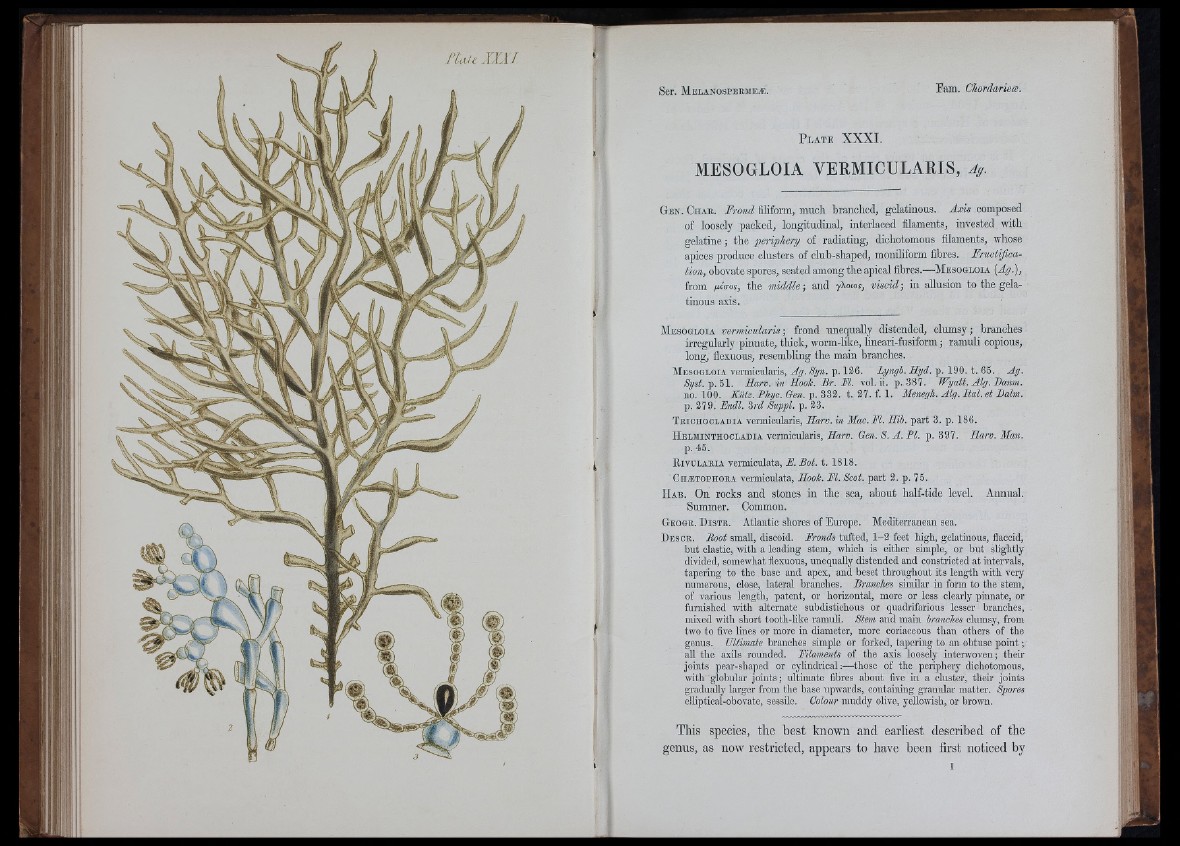
P l a t e XXXI.
MESOGLOIA VERMICULARIS, Jg.
Gen . C h a k . Frond filiform, much branched, gelatinous. Axis composed
of loosely packed, longitudinal, interlaced filaments, invested -«1111
gelatine; the periphery of radiating, dichotomous filaments, whose
apices produce clusters of club-shaped, moniliform fibres. Fructification,
obovate spores, seated among the apical fibres.—M e so g lo ia [Ag),
from /ifo-or, the middle; and yXoior, viscid; in allusion to the gelatinous
axis.
M e so g lo ia vermicularis; frond unequally distended, clumsy; branches
irregularly pinnate, thick, worm-like, lineari-fusiform; ramuli copious,
long, flexuous, resembhng the main branches.
Mesogloia vermicularis, Ag. Syn. p. 136. lyngh. Hyd. p. 190. t. 65. Ag.
Syst. p. 51. Harv. in Hook. Br. M. vol.ii. p.,387. Wyatt. Alg. Damn.
no. 100. Kiitz. Phyc. Gen. p. 332. t. 27. f. 1. Menegh. Alg. Ital. et Balm.
p. 279. Endl. 3rd Suppl. p. 23.
Trichool.adia vermicularis, Harv. in Mac. El. H ii. part 3, p. 186.
H e lm in th o c la d ia vermicularis, Harv. Gen. S. A . PI. p. 397. Harv. Man.
p. 45.
llivuLARiA vermiculata, E .B o t. t. 1818.
Cha;tophora vermiculata. Hook. FI. Scot. part 2. p. 75.
IIa b . On rooks and stones in the sea, about liaK-tide level. Aimual.
Summer. Common.
Geogr. Distr. Atlantic shores of Europe. Mediterranean sea.
Descr. Boot small, discoid. Eronds tufted, 1 -3 feet high, gelatinous, fiaccid,
but elastic, with a leading stem, which is either simple, or but sliglitly
divided, somewhat flexuous, unequally distended and constricted at intervals,
tapering to the base and apex, and beset throughout its length ivith very
numerous, close, lateral branches. Branches similar in form to the stem,
of various length, patent, or horizontal, more or less clearly pinnate, or
furnished with alternate snbdistichous or quadrifarious lesser branches,
mixed with short tooth-like ramuli. Stem and main branches clumsy, from
two to five lines or more in diameter, more coriaceous than others of the
genus. TJltimate branches simple or forked, tapering to an obtuse p o in t;
aU the axils rounded. Eilaments of the axis loosely interwoven; then-
joints pear-shaped or cylindrical:—those of the periphery dichotomous,
with globular joints; ultimate fibres about five in a cluster, their joints
gradually larger from the base upwai’ds, containing granular matter. Spores
elliptical-obovate, sessile. Colour muddy olive, yeUowish, or brown.
Tliis species, the best known and earliest described of the
genus, as now restricted, appears to have been first noticed by
I